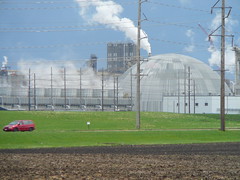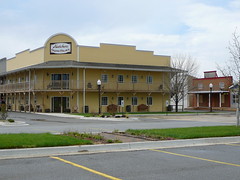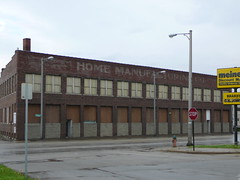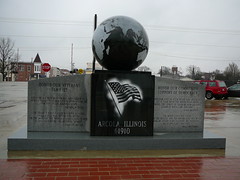Last week I had to make a drive over to Peoria to give a presentation to the Laborers Union. I took the long way home, through Decatur, so I could get some pictures of Tate and Lyle, ADM, and Caterpillar. It was a rainy day, so I didn't get a lot of great pictures. But it was certainly worth the trip to discover the Heartland Community Church and its Grand Palace convention center.
Decatur is a town that has had some hard times of late. It was, and in some ways still is, a union town. But the biggest and boldest of the unions have been crushed or put in their place. In the mid-1990s, there were major lockouts and strikes at A.E. Staley (owned by British multinational Tate & Lyle), Caterpillar (still US-owned but globally oriented market-wise), and Bridgestone-Firestone (owned by Japanese investors), each of which resulted in various styles of defeat (Steve Franklin chronicles these events in his book Three Strikes). Globalized capital rules Decatur, not without a fight, but it rules anyway.
You could easily spend weeks photographing Decatur. The industrial landscape is like a little piece of Chicago's Southside. A massive rail yard cuts through the middle of town, connecting the Tate and Lyle (formerly A.E. Staley) corn processing mill and two ADM facilities. ADM has always run nonunion. Staley has been union since the 1940s. During the Staley lockout, ADM built a pipeline to the two companies to keep them supplied with raw material.
I was on my way out of town when the Heartland Community Church caught my eye. It's just up the road from the big Archer Daniels Midland (ADM) Mill, across from the community college, and its sign advertised an upcoming water baptism. Behind the church are two buildings that look like they are right out of a Hollywood Western film: they look like a very clean version of the town in Little House on the Prairie. This is the "Grand Palace," apparently operated by the church as a wedding and business-meeting space.
This is a very sophisticated church operation with a professional website, a cappuccino bar, good music, video and audio downloads of sermons, and other trappings of modern evangelical churches. There are "ministries" that designed for youth, families, drama, music, etc. In a town with a significant African American community, the church's website projects a multiracial membership, although most of the images look like stock. The elders are all white men. Decatur's Heartland Church appears to be independent. But it's interesting that there are more than 15,000 hits for the phrase "Heartland Community Church" on Google, most seem to be in the Midwest.
And then there's the Grand Palace. The downloadable brochure refers to the building's "circa 1800s style interior" and suggests that clients can "Step back in time and experience mid-western hospitality at its finest." When I was there in the parking lot I actually thought, no, this can't be run by the church, it's too obvious. But it is part of the church.
For me this is just a great example of how "heartland" is deployed as a cultural and business symbol. With a few spare words, and the loud-and-clear message of architecture, the church can evoke what is believed to be the sincerity and simplicity of the nineteenth century smalltown midwestern experience to win souls and to make money. In a way it makes sense that this cozy collection of nostalgia and modernity sits within sight of ADM and Caterpillar, on the edge of a city that has been devastated by this processes we call globalization. The property is figured as a site of refuge, a safe haven from which members go out to evangelize (locally and globally according to the staff list). But with its cappuccino bar and banquet hall, it is a haven with all the trappings of a mall. I have no reason to doubt the sincerity of the church's members or leaders. They have cleverly drawn upon a powerful current of our culture. Heartland: the warm feeling of home, carefully packaged for retail.
Here are a few other shots from my trip, and you can see others here.
Global | Local | Middle
Monday, April 30, 2007
Thursday, April 19, 2007
Globes in the Heartland
As I mentioned in the comments to my last post, I have been planning to snap a picture of this veteran's memorial since I first saw it on a bright sunny day last fall. Unfortunately, by the time I got back down to Arcola, it was a miserable rainy day. No picture could quite do this thing justice, in part because it is the town and the countryside beyond that make it so...strange.
Like every little town, Arcola has a few claims to fame. The creator of Raggedy Ann lived here, and the area was once the biggest producer of brooms in the US. The first settlement in the area was named, I kid you not, Bagdad. Currently, tourism is based heavily on the Amish community living in the surrounding countryside. The commercialization of Amishness is well worth a post in itself. But not today.
The memorial sits on the edge of the parking lot of the Arcola Center, at Main Street and Route 45 for those of you looking for a road trip. Across Main Street is a Casey's (the small town equivalent of 7-11), across Route 45, the Illinois Central tracks and beyond that the old downtown area.
There are many ways to honor veterans. The black marble here certainly reminds me of the Vietnam Memorial in DC. But this is the first one I've seen that uses a globe as the central symbol. If there are others out there, I'd be interested to know.
I would also be interested to know what folks in Arcola think about it. I'm reluctant to subject it to the obvious critique because, well, people from these parts are currently dying on a regular basis in Iraq. I suspect that if I used the word "empire," Arcolans would object. They might say, no it simply says that our people have died all over the world.
Yes, the monument definitely looks like a grave stone. If it is a symbol of empire, it is not a triumphant symbol at all. The globe weighs us down with responsibilities, and it demands the lives of our young. It also seems uneasily balanced atop the American flag. The hierarchy of place is at once accurate (from top to bottom: Earth, United States, Arcola), and chilling because the place we inhabit (the town's mailing address) is buried at the bottom. Hometown America is ultimately just the place they ship the coffins.
What say you, dear readers? How is your town memorializing the war dead in our global campaign against terrorism? Is there a seed of rejection in these monuments that progressives might embrace, or just isolationism and xenophobia?
Like every little town, Arcola has a few claims to fame. The creator of Raggedy Ann lived here, and the area was once the biggest producer of brooms in the US. The first settlement in the area was named, I kid you not, Bagdad. Currently, tourism is based heavily on the Amish community living in the surrounding countryside. The commercialization of Amishness is well worth a post in itself. But not today.
The memorial sits on the edge of the parking lot of the Arcola Center, at Main Street and Route 45 for those of you looking for a road trip. Across Main Street is a Casey's (the small town equivalent of 7-11), across Route 45, the Illinois Central tracks and beyond that the old downtown area.
There are many ways to honor veterans. The black marble here certainly reminds me of the Vietnam Memorial in DC. But this is the first one I've seen that uses a globe as the central symbol. If there are others out there, I'd be interested to know.
I would also be interested to know what folks in Arcola think about it. I'm reluctant to subject it to the obvious critique because, well, people from these parts are currently dying on a regular basis in Iraq. I suspect that if I used the word "empire," Arcolans would object. They might say, no it simply says that our people have died all over the world.
Yes, the monument definitely looks like a grave stone. If it is a symbol of empire, it is not a triumphant symbol at all. The globe weighs us down with responsibilities, and it demands the lives of our young. It also seems uneasily balanced atop the American flag. The hierarchy of place is at once accurate (from top to bottom: Earth, United States, Arcola), and chilling because the place we inhabit (the town's mailing address) is buried at the bottom. Hometown America is ultimately just the place they ship the coffins.
What say you, dear readers? How is your town memorializing the war dead in our global campaign against terrorism? Is there a seed of rejection in these monuments that progressives might embrace, or just isolationism and xenophobia?
Monday, April 09, 2007
Local Symbols of Globalization
Found this on a Sunday drive in the country: Bement, Illinois, population 350. The "O" in "Topflight" is a globe with North and South America showing, and bean and corn stalks growing out the North Pole. As I listen to the local agricultural radio report telling me about the weather in the growing areas of southern Brazil (where more than a few big Illinois farmers have land, apparently), I wonder if this logo is a symbol of globalization or empire? Both? Discuss.
Subscribe to:
Posts (Atom)







